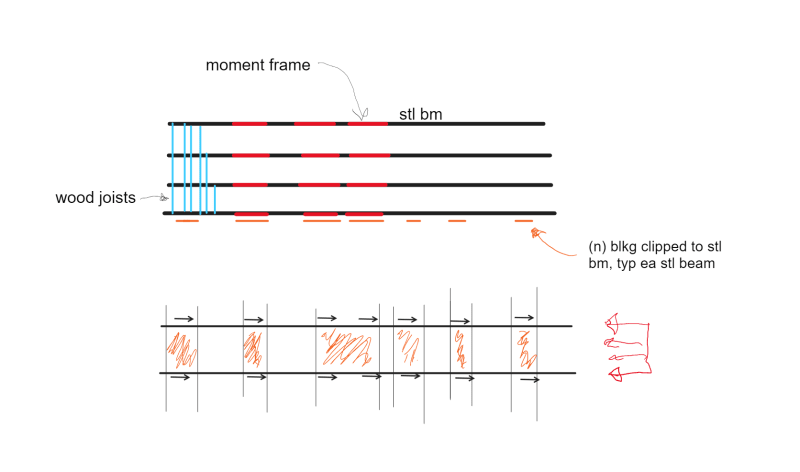driftLimiter
Structural
I'm working on seismic retrofit for an existing building and would like to investigate possibly using partial length diaphragm boundary nailing in order to reduce/eliminate the need for new full length straps over blocking. This isn't something I normally would try, but since this is retrofit work it will be especially intrusive to add new floor straps and verify boundary nailing. So I thought I'd see what other options I have.
After a quick refresher on Terry Malone's book it seems like the only way he allows for partial length collectors is when using a transfer diaphragm. Perhaps I could use a similar approach but I'm not feeling like it will be particularly successful without ripping apart the existing and adding boundary nailing and straps everywhere.
What my goal really is, is to provide minimal new blocking and boundary nailing over existing collectors at some intermittent spacing. I would provide full length blocking and boundary nailing over new lateral frames. Important to note that I have good full length collectors but the existing blocking is not full depth, and the nailing of the WSP to the blocking is unknown.
The concern is that without a full length boundary nailing, the WSP diaphragm needs to resist some tension and compression. And some of that tension has to travel through WSP joints (cross grain bending in wood member below).
Does anyone know of a rational approach to use partial length boundary nailing? The existing floor diaphragm is 1"+ WSP, my biggest concern with tension is the at the joints.
After a quick refresher on Terry Malone's book it seems like the only way he allows for partial length collectors is when using a transfer diaphragm. Perhaps I could use a similar approach but I'm not feeling like it will be particularly successful without ripping apart the existing and adding boundary nailing and straps everywhere.
What my goal really is, is to provide minimal new blocking and boundary nailing over existing collectors at some intermittent spacing. I would provide full length blocking and boundary nailing over new lateral frames. Important to note that I have good full length collectors but the existing blocking is not full depth, and the nailing of the WSP to the blocking is unknown.
The concern is that without a full length boundary nailing, the WSP diaphragm needs to resist some tension and compression. And some of that tension has to travel through WSP joints (cross grain bending in wood member below).
Does anyone know of a rational approach to use partial length boundary nailing? The existing floor diaphragm is 1"+ WSP, my biggest concern with tension is the at the joints.

